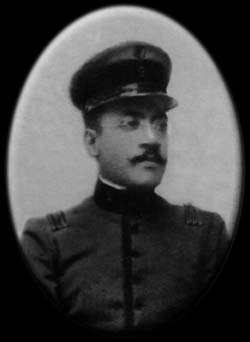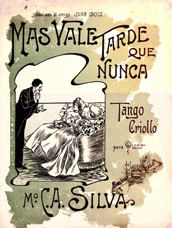By
Cayetano Silva, from the “San Lorenzo” march to tango criollo

he composer and bandleader Cayetano Alberto Silva was born on 7 August 7th, 1868, in the city of San Carlos (Departamento Maldonado, Uruguay) and died in Rosario (province of Santa Fe, Argentina), on January 12, 1920. Little attention the usual biographical dictionaries have given to him, even though he was the composer of the famous march “San Lorenzo”. He also composed a tango.
 He died poor, even worse, in extreme poverty. By that time the collection of royalties for composers or authors was not yet duly organized.
He died poor, even worse, in extreme poverty. By that time the collection of royalties for composers or authors was not yet duly organized.
The march was initially dedicated to general Pablo Riccheri and it had had to bear his name but they say that he declined to accept such recognition in life. Then it became the “San Lorenzo”, Ricchieri’s birthplace. His neoclassic lyrics, with his two so popular initial words “Febo asoma” (Phoebus appears), belong to Carlos Javier Benielli, an the educator and poet from Mendoza.
Other compositions of his that stood out were: “Río Negro” —a march dedicated to general Julio A. Roca—, another march was “Estelita”, later the waltz “Marineritas”, the mazurka “Juanita [b]”, the march “Anglo-Boers” —dedicated to the Anglo-Argentine community of Venado Tuerto—, the march “22 de julio” —dedicated to general Nicolás Levalle—, other marches were “Monterrey”, “San Genaro” and “Curupaity” —dedicated to the officers of the 3rd. and 4th. regiments of infantry— which has been sung at schools as it also was known as “Tuyuty”.
 To these pieces we have to add one never imagined, a tango entitled: “Más vale tarde que nunca”, tango criollo for piano, dedicated to my friend Juan Croce and published in Buenos Aires by David Poggi and Son, a music house located on 418/420 Carlos Pellegrini Street.
To these pieces we have to add one never imagined, a tango entitled: “Más vale tarde que nunca”, tango criollo for piano, dedicated to my friend Juan Croce and published in Buenos Aires by David Poggi and Son, a music house located on 418/420 Carlos Pellegrini Street.
When he was teacher in the province of Mendoza he founded the band of the Firemen. But he was a precocious bandleader because when he was around tewenty he was bandleader of the band of the 7th. Regiment of Infantry. He had began in it by playing horn at age 17. Thereafter he led other military bands based in Buenos Aires, Campo de Mayo, San Juan, Río Cuarto and Mendoza.
He was greatly disappointed when based in Rosario he was promised to be appointed conductor of the city band, something he duly deserved but later other influences changed what he had been announced. This could have solved his financial problems and then he fell into a deep depression.
As for the Marcha San Lorenzo, nobody even thought that that was an immortal music. To such an extent that since some years before, for our surprise and annoyance, it is played for the change of guards in the royal custody of the queen of England.
As for “Más vale tarde que nunca” we have no information if there is any recording. But there are three renderings in the tango tradition of his famous march by the following: Orquesta Roberto Firpo (1927), Orquesta Juan de Dios Filiberto (1935) and one recorded much later by Las Guitarras de Oro (1993).
Our country is used to be ungrateful with some of its loyal subjects. General Martín Rodríguez, under whose government a large part of the reforms made by Rivadavia were enforced, died in poverty. The Spanish patriot Domingo Matheu went bankrupt by supporting the Revolución de Mayo. Juan Larrea committed suicide because he was unable to pay his debts and he had a tragic sense of honor. Cayetano Silva had no better luck even though his great march “San Lorenzo” outlives him.